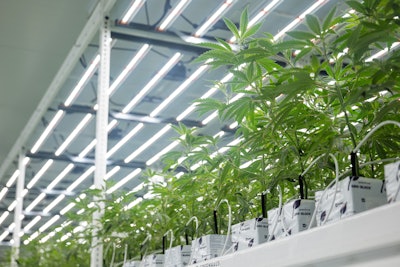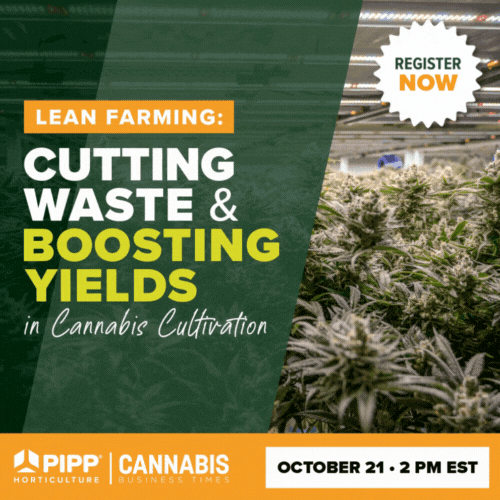
Commercial cannabis cultivation definitely comes with a learning curve, but that curve differs for everyone. Experienced growers from outside the commercial sector may have solid growing practices covered, but commercial cultivation presents a new and diverse set of challenges. Considerations such as regulatory compliance, cultivation goals, a state’s or region’s market potential, labor and workflow, among others, become magnified in importance.
To help transitioning growers zero-in on the aspects that have the most significant impact on overall business success, Casey Rivero, cannabis solutions architect at Fluence, shares his insights from more than two decades of firsthand experience designing, building and operating cultivation facilities.
1. Regulatory and Compliance Considerations
“When you're developing a cannabis production facility on the commercial level, regulatory and compliance is key to everything else,” Rivero says. “Because it doesn't matter how great of a grower you are, how much money you spent on your system, if you don't understand the ins and the outs of what you're actually legally able to do, then you're only looking for trouble—continual trouble.”
As Rivero notes, cannabis cultivation is heavily regulated from the federal level down to the local level. Your first step, a critical one, is to understand all the limits and the allowances facing a commercial grow in your specific location. “If we aren't aware of the regulations before we even decide to build the facility, then we could be just building ourselves into errors in the future,” he says.
Should you seek professional assistance or advice? Rivero says yes. “Obviously, it costs more money. But many times, doing it right the first time saves a lot of money in the future,” he says. He recommends hiring legal counsel and/or a compliance expert who is familiar with commercial cannabis cultivation regulations and requirements.
2. Cultivation Strategy and Market Demands
“Your cultivation strategy is what is going to determine your labor requirements, the systems that you develop, the facility that you design and build, and what genetics you try and produce for the market,” Rivero says, adding that all these things are determined by what the market allows, from a legal or regulatory perspective as well as consumer demand. For example, on the regulatory side, not all states and/or municipalities allow for outdoor or greenhouse cultivation, and most have maximum plant counts or canopy limits for any type of cultivation operation.
You may have plans for a certain square footage and aspirations for specific yields, as well as types of products for the medical or recreational market in your area. But Rivero says the big question is how much of these products you’re able to sell. Your cultivation strategy must revolve around what your market supports.
Evaluating your future market should involve a comprehensive look at data-driven reports from cannabis market intelligence firms and media outlets on aspects ranging from the regulatory environment and market size/saturation, including the ratio of growers to retailers, to consumer trends. While trajectories in legalization are obviously important, so are cultural trajectories as consumers grow more sophisticated or markets move from medical to recreational.
“Your cultivation strategy really determines, ultimately, your business model,” he says. “That strategy directly affects things like your yield, your marketability, your brand presence, your go-to-market strategy and those types of things.”
Rivero says there are a myriad of ways to cultivate cannabis and develop a business around cultivation, and no one way is better than the other. “It all really depends on what you’re trying to achieve and what you’re allowed to do—and how much funding you have to do it,” he says. Don’t overlook that final point.
What works on a smaller scale doesn’t always work on a larger scale, especially when factors like employment, equipment and power costs impact on your margins and your bottom line. So, a realistic and viable cultivation strategy is crucial.
3. Facility and Infrastructure Design
Rivero says that step one in the design process doesn’t actually involve design—it’s finding the right location for your intended cultivation operation. He says that many growers have challenges when what seemed like a perfect location ends up falling short on crucial aspects such as available power, available labor, water availability or quality, the ability to secure the site, or similar considerations. “You can create an uphill battle for yourself, or you could have realized that this might be a limiting factor early on,” he adds.
Understanding your target location thoroughly, from benefits to limitations, is essential to implementing an effective design. “Poor facility designs lead to inefficiencies, increased costs, potential environmental issue or hazards—things that you might end up spending more money on in the future,” Rivero says.
Designing a facility that’s purpose-built for exactly what you’re trying to achieve in your market, including any potential for future business and expansion, is a key driver for your infrastructure design. Is your goal premium flower or extracts? Do you aspire to be a smaller-scale craft producer, or are your goals to become a multistate operator? Whatever your answer, being realistic about your funding is critical to success. A flower room at Peninsula Gardens, using Fluence LED lights.Photo courtesy Fluence
A flower room at Peninsula Gardens, using Fluence LED lights.Photo courtesy Fluence
Rivero suggests asking the question: “Do I have enough funds to complete what I’m trying to do, or should I focus on really knocking it out in half the square footage that’s allowed to me, then expand as we’ve developed a solid, tight system?”
He adds that the cannabis industry has many examples of facilities that never got finished because dreams exceeded funding and growers lost focus on what could be done, and done exceptionally well, right now.
4. Labor Access and Workflow Management
“Labor and workflow are some of the most underutilized and overlooked things in a facility with growers that are going from a smaller scale to a larger scale,” Rivero says, noting that your labor can make or break the margin on your product.
When building or designing a facility, the first labor consideration is whether your chosen area has access to a solid local labor pool. Properties, utilities and other costs can be lower in more remote areas, making these areas appealing when site shopping; however, remote areas can pose hiring challenges. Even employees who don’t mind a 90-minute one-way commute when the facility and the job are new may feel different six months down the road.
Another major consideration is whether you’re hiring for specific functions to maximize your results or you’re just hiring a crew. “There’s this expression about too many cooks in the kitchen,” Rivero says. “You see that same thing heavily in cannabis—too many growers in the grow room, as opposed to a job and a function that is maximized.” From nutrition and plant health to pest control, you can hire and train for each specific function in the grow. Then everyone knows their job and its responsibilities, so labor and intellectual input is optimized, and every function is maximized.
Of course, there’s also the flip side when there’s not enough labor and burnout rates start to rise. “Operating ‘lean’ is important, but you want your employees to show up happy every day,” Rivero says. Overworked, burned out employees are more likely to make mistakes. And mistakes can destroy months of work and labor.
Rivero emphasizes hiring experienced growers is important. But he suggests focusing on growers who “are excited to learn and excited to own their jobs and own what they do and contribute to the team, the culture and the success of the company.”
Success with teams, workflow and labor depends on having strict standard operating procedures (SOPs), Rivero says, but your SOPs must be able to evolve so your operations can adapt in response to new developments in your market, such as overproduction and/or price compression.
“Always being able to adapt and alter your business performance and your SOPs based on what the market is doing, based on what the business is doing, is really important,” he says.
5. Equipment and Vendor Relationships
“There are 1,000 ways to build 1,000 square feet. It all really depends on the level of control we want to have over our facility and over our crop production,” Rivero says. Greater control requires a higher level of sophistication of both the equipment and your understanding of what it does compared to something less sophisticated. It also requires more money and foresight in design.
“The equipment that you put in has to match the cultivation plan and business plan,” he says. As an example, he notes the many ways to implement lighting in a facility. Not just spectrum, but intensity, fixture type, specific fixture deployment for different types of cultivation or end products, and more.
Rivero says you need to know where you stand in terms of your cultivation and business skills and the overall landscape in your market. ““The equipment and the controls that you install need to support what you're good at, what your team's good at, and your cultivation plan based on the market needs and the products that you're creating,” he says.
Some equipment needs higher levels of interaction and generally benefits from more in-depth relationships with the manufacturer or supplier. “The deeper level of relationship that you have with the manufacturer, the supplier, not only helps you as an organization ensure that you're using the equipment to its standards, to its maximum capability that you've tried to achieve, but it also allows them to become a better manufacturer and a better supplier and a better cheerleader for your success,” he says.
Looking back at his own career building, owning and operating multiple operations in multiple states before joining Fluence in 2018, Rivero says his most important assets were the relationships he had with his vendors and suppliers. Vendors who provide an ongoing system of support can be the greatest asset for transitioning growers as well.
“I did business with people on the value that their company brings to my company and [whether] it's reciprocal, and I think that gets overlooked a lot nowadays,” Rivero says. “… To me, if I can get value for my business that is more than just a product, I’m going to choose that every time.”
More from our latest newsletter:
Sponsored: How AtlantiCann Increased Yields, Profitability With an LED Retrofit
Sponsored: The New VYPR 4: Optimized Spectrum, Proven Performance


